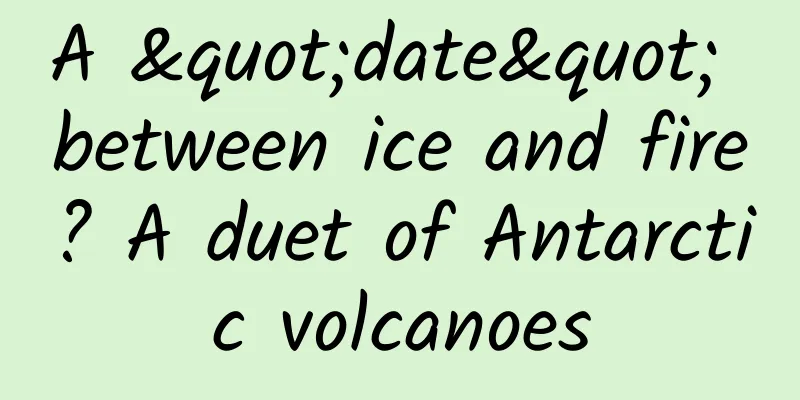A "date" between ice and fire? A duet of Antarctic volcanoes

|
Cold, still, solidified, white - that is ice and snow; hot, surging, leaping, fiery red - that is magma. I don't know when, this ice and fire met and came to the holy and vast Antarctic continent together, and built a hot mountain on this ancient and extremely cold ice field. Looking up at the top of the mountain, smoke is curling and flames are rising to the sky; looking down at the crater, magma is rolling and hot steam is rising. This magical fusion of ice and fire is amazing and makes people impressed by the magical scene created by nature. This is the must-see scenery of Antarctica - Mount Erebus. Speaking of this volcano, its discovery has an unusual story. On January 27, 1841, British explorer James Clark Ross led the "Erebus" expedition ship to explore the South Magnetic Pole. When they arrived at an island south of the Antarctic Circle, they were surprised to find an erupting volcano. On the lonely white ice field, flames and smoke were gushing out from the crater. Although it was summer in Antarctica, the sun was strong and the red flames were still very eye-catching, adding a lot of life to the lifeless ice and snow. Ross excitedly wrote in his sailing diary: "Today, we found a mountain with an altitude of nearly 4,000 meters. A lot of flames and smoke came out of the top of the mountain. The scenery is very spectacular." In amazement, Ross named the island after himself and named the volcano "Mount Erebus" after the name of the expedition ship. Mount Erebus is one of the world's ten most famous volcanoes. It is located at 77°35′ south latitude and 167°10′ east longitude. It is the southernmost volcano on Earth. The mountain is 3,794 meters above sea level. The diameter of the crater is about 805 meters. It is oval in shape, 274 meters deep, and has steep walls. There is no ice or snow in the crater, nor is there any water. Instead, it is a hot lava lake. On the edge of the south side of the crater, there is a fumarole that slowly spews steam. In the cold climate, the steam condenses into a tall ice tower; the ice tower is penetrated by the steam that continues to spew out, forming an ice cave, which is strange and magnificent, and very unique. The eruption of Mount Erebus is now intermittent. As the intensity of underground magma activity changes, the frequency of its eruption also changes. From 1972 to 1976, it erupted an average of 2.5 times a day. Since the beginning of 1978, the number of eruptions has increased to 3.6 times a day, with a maximum of 6 times. Later, it gradually became milder. Erebus Crater - Fire and Ice Volcanic eruptions are sometimes as quiet as a virgin, and sometimes as fast as a rabbit, often causing trouble and danger to scientists. In December 1978, American and New Zealand scientists went 70 meters deep into the crater to collect samples. Suddenly, magma began to erupt and surge. It was terrifying to see the red magma rising rapidly, and a large amount of volcanic gas mixed with solid matter ejected by the volcano soared into the air. In the tension, a piece of magma splashed on the legs of the New Zealand team member, instantly burning his pants. The situation was critical, and other team members struggled to rescue him and saved him from misfortune. However, luck does not always favor people. On November 28, 1979, a New Zealand Airlines DX-10 passenger plane full of American tourists was flying around the volcano. The tourists were looking at the magical volcanic scenery from the air. Unexpectedly, the plane crashed headfirst near the crater for unknown reasons. More than 260 people on board were killed, and the cause of the accident is still unclear. Mount Erebus is not the only volcano on the Antarctic continent. Geologists have discovered more than a dozen volcanoes in the southwest of Antarctica alone, but these volcanoes have long ceased activity and are covered by continental glaciers more than 2,000 meters thick. Some of them only have small mountain peaks left. Another active volcano is Deception Island, located near the tip of the Antarctic Peninsula. It erupted on December 4, 1967, and reduced three scientific research stations in Chile, Argentina and the United Kingdom to ashes. Because the Argentine station issued a forecast in advance, all personnel in the three stations were quickly evacuated and survived. The mysterious and beautiful Antarctica, where ice and fire blend together, offers stunning views. Although it is a joy to be there, it is also dangerous. Safety during the tour should be the first priority when enjoying the beautiful views. Author: Biological Evolution and Geohistory Team of the Geological Society of China |
Recommend
Black Widow withdrawn from theaters, release date to be determined, originally planned to be released in North America on May 1
Original title: Due to the epidemic, "Black ...
I always feel that men are greasy, but why are men's faces more oily?
Sometimes I have to sigh that it is not easy for ...
I analyzed 100 cases and summarized 3 ways to create creative Dragon Boat Festival activities
When I opened my eyes on the morning of May 2, I ...
How to promote APP in 2018? Complete guide to explaining channel promotion!
Whether you are a rookie who has just entered the...
E-commerce operation: holiday promotion traffic field!
In the mobile Internet environment, new consumer ...
Public account operation: How to attract the audience’s scarce attention amidst an overabundance of content?
Official accounts are the only traffic pool in th...
What role does Tencent play in the “Internet +” ecosystem?
Yesterday afternoon, the 2015 "Internet + Ch...
Analysis of "9377 Games" advertising strategy and marketing effectiveness
Today, let’s take a look at a classic promotion c...
DIGITIMES Research: Global electric vehicle penetration is expected to exceed 30% in 2025
Recently, according to DIGITIMES, as the penetrat...
Are more and more people unsubscribing? You lack such a push data analysis method
Message push is the best channel for APP operatio...
Razer launches the world's first triple-screen laptop with a total resolution of 11520×2160
There will be black technology at CES every year, ...
Beware of slipping! What to do if you encounter "freezing rain" on the highway?
In the cold winter, a special meteorological phen...
The main reason old users buy iPhone 7 is Merrill Lynch: battery life has been improved
If you’ve used an iPhone before, you’ll know that...
Why should we start with farming to protect these "leopards"?
Hello everyone, I am Shi Qijing from Cat Alliance...
As a mobile fitness app, what is Keep’s financial approach?
Not long ago, I saw an article about a red envelo...









